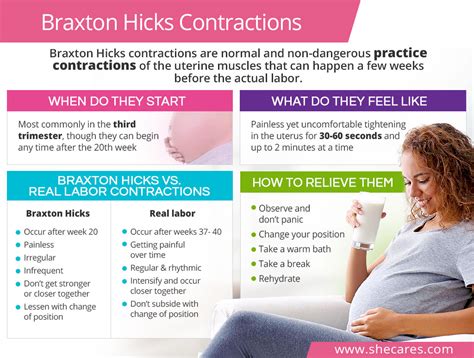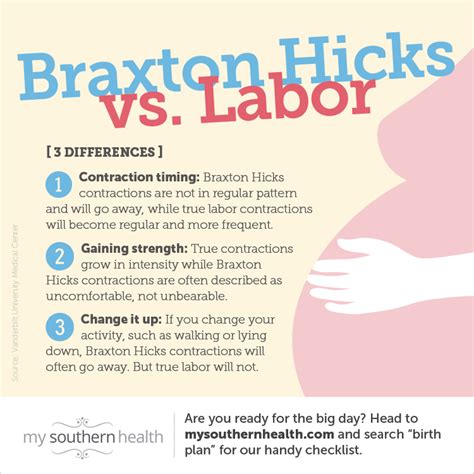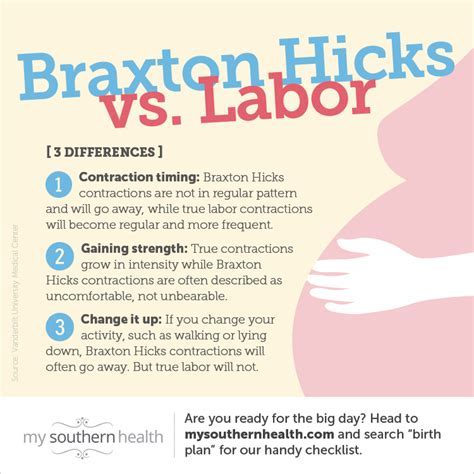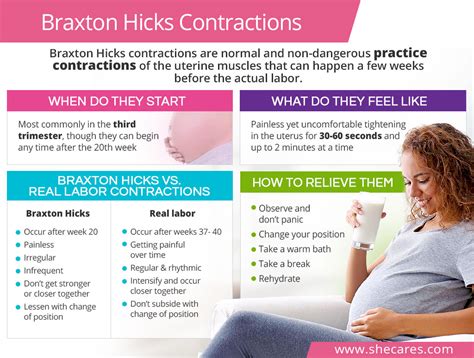Intro
Braxton Hicks contractions are a normal part of pregnancy, but many expectant mothers are unaware of the significance and characteristics of these contractions. As the body prepares for labor, it is essential to understand the role of Braxton Hicks contractions and how they differ from real labor contractions. In this article, we will delve into the world of Braxton Hicks contractions, exploring their causes, symptoms, and importance during pregnancy.
Braxton Hicks contractions are named after the British doctor who first described them in the 19th century. These contractions are a natural part of pregnancy, typically starting around the second trimester. They are often referred to as "practice" or "false" labor, as they help the uterus prepare for the real thing. However, many women are unsure about what to expect from Braxton Hicks contractions, and it is not uncommon for them to be mistaken for real labor.
As pregnancy progresses, the uterus becomes more active, and Braxton Hicks contractions become more frequent and intense. This can be a reassuring sign that the body is getting ready for labor, but it can also be a source of anxiety for some women. By understanding the facts about Braxton Hicks contractions, expectant mothers can better navigate this aspect of pregnancy and feel more confident as they approach labor.
What are Braxton Hicks Contractions?

Causes of Braxton Hicks Contractions
The exact causes of Braxton Hicks contractions are not fully understood, but several factors are thought to contribute to their occurrence. These include: * Hormonal changes: The hormone oxytocin, which plays a role in labor, may also contribute to Braxton Hicks contractions. * Uterine stretching: As the uterus expands to accommodate the growing fetus, it may contract and relax in preparation for labor. * Fetal movement: The movement of the fetus can stimulate the uterus and trigger Braxton Hicks contractions. * Dehydration: Not drinking enough water can cause the uterus to contract, leading to Braxton Hicks contractions.How to Identify Braxton Hicks Contractions

Distinguishing Braxton Hicks from Real Labor
It is essential to be able to distinguish Braxton Hicks contractions from real labor contractions, as this can help expectant mothers determine when to seek medical attention. Some key differences between Braxton Hicks and real labor include: * Contractions that become more frequent and intense over time * A change in the pattern of contractions * The presence of bloody show or a rupture of membranes * A feeling of intense pressure in the pelvis or backManaging Braxton Hicks Contractions

When to Seek Medical Attention
While Braxton Hicks contractions are generally not a cause for concern, there are certain situations in which expectant mothers should seek medical attention: * Contractions that are extremely painful or intense * Contractions that are accompanied by vaginal bleeding or a rupture of membranes * Contractions that are more frequent than 5 minutes apart * A fever or other signs of infectionBenefits of Braxton Hicks Contractions

Preparing for Labor
As the due date approaches, expectant mothers can take steps to prepare for labor and make the process as smooth as possible. This includes: * Attending childbirth education classes * Practicing relaxation techniques, such as deep breathing or meditation * Creating a birth plan * Staying physically active and maintaining a healthy dietCommon Myths and Misconceptions

Conclusion and Next Steps
In conclusion, Braxton Hicks contractions are a normal and essential part of pregnancy. By understanding the causes, symptoms, and benefits of Braxton Hicks contractions, expectant mothers can better navigate this aspect of pregnancy and feel more confident as they approach labor. If you have any questions or concerns about Braxton Hicks contractions or any other aspect of pregnancy, be sure to speak with your healthcare provider.What are Braxton Hicks contractions?
+Braxton Hicks contractions are mild, intermittent contractions of the uterus that occur during pregnancy.
How can I distinguish Braxton Hicks contractions from real labor?
+Braxton Hicks contractions are typically milder and less frequent than real labor contractions, and may not follow a predictable pattern.
What are some common causes of Braxton Hicks contractions?
+Common causes of Braxton Hicks contractions include hormonal changes, uterine stretching, fetal movement, and dehydration.
How can I manage Braxton Hicks contractions?
+Managing Braxton Hicks contractions can involve staying hydrated, changing positions, practicing relaxation techniques, and applying heat or cold to the abdomen.
When should I seek medical attention for Braxton Hicks contractions?
+Expectant mothers should seek medical attention if they experience extremely painful or intense contractions, contractions accompanied by vaginal bleeding or a rupture of membranes, or contractions that are more frequent than 5 minutes apart.
